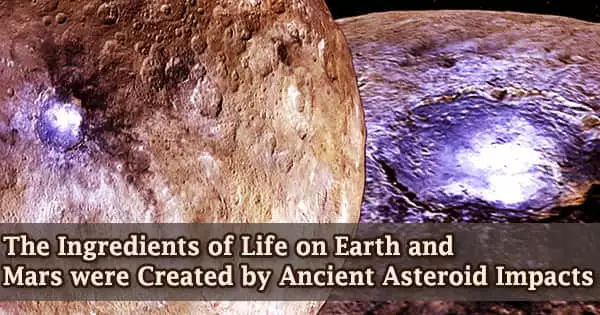According to a new study, asteroid impact sites in the ocean may play a key role in understanding the genesis of life’s basic components. The development of amino acids, which serve as the building blocks for proteins, was identified in the study, proving the importance of meteorites in delivering life’s chemicals to Earth, and maybe Mars.
Extraterrestrial delivery, such as via meteorites, and endogenous production are two possible hypotheses for the origins of life’s basic molecules. Amino acids and other biomolecules have been found in meteorites, indicating the former.
Tohoku University, the National Institute for Materials Science (NIMS), the Center for High-Pressure Science & Technology Advanced Research (HPSTAR), and Osaka University researchers recreated the processes that occur when a meteorite collides with the ocean.
To accomplish so, they used a single-stage propellant pistol to explore the interactions between carbon dioxide, nitrogen, water, and iron in a laboratory impact facility. The production of amino acids like glycine and alanine was discovered through their simulation. These amino acids are essential components of proteins, which catalyze a wide range of biological processes.
Making organic molecules form reduced compounds like methane and ammonia are not difficult, but they are regarded as minor components in the atmosphere at that time. The finding of amino acid formation from carbon dioxide and molecular nitrogen demonstrates the importance in making life’s building blocks from these ubiquitous compounds.
Yoshihiro Furukawa
Carbon dioxide and nitrogen were utilized as carbon and nitrogen sources because these gases are thought to be the two principal components of the Hadean Earth’s atmosphere, which existed more than 4 billion years ago.
The corresponding author from Tohoku University, Yoshihiro Furukawa, explains, “Making organic molecules form reduced compounds like methane and ammonia are not difficult, but they are regarded as minor components in the atmosphere at that time.” He adds, “The finding of amino acid formation from carbon dioxide and molecular nitrogen demonstrates the importance in making life’s building blocks from these ubiquitous compounds.”
The idea that there was once an ocean on Mars opens up new possibilities for research. When the ocean was present on Mars, carbon dioxide and nitrogen were most likely the main component gases of the atmosphere. As a result, impact-induced amino acid synthesis on ancient Mars might be a source of life’s elements.
Furukawa says, “further investigations will reveal more about the role meteorites played in bringing more complex biomolecules to Earth and Mars.”





